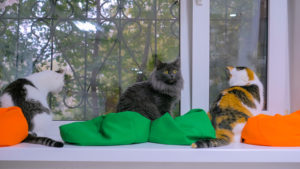Many of us are spending a lot of time at home right now. Even a brief walk around the neighborhood feels like a special experience, and we may see things we never noticed before. With this perspective, we no longer take for granted the views from our windows. Assuming we could take this perspective and apply it to our pets, what can we do to make an interesting visual environment for them every day?
What Dogs Want to See
Dogs prefer to be with their familiar social group. They prefer to see, smell, and be around their people and other pets they are bonded to. But beyond your presence and positive attention, they need other types of enrichment. Here is how we would craft the home environment to be most visually enjoyable for them.
- Give dogs a spot where they can lie comfortably and observe their surroundings. Many dogs will lie in a space where they can watch their family members. Notice this and encourage it! Put your dog’s bed where she wants to be. Never banish your dogs by locking them into a space (such as a crate or small room) in a part of the house with no connection to family activities.
- Block anxiety-inducing views. Notice what makes your dog crazy, such as seeing the letter carrier walking up the sidewalk. It is best to block such views, or your dog will be on alert an unhealthy amount of time.
- Open views to enjoyable spaces, such as the backyard, where birds and squirrels provide entertainment.
- Let them get up higher. We will often place a platform 24 to 30 inches above the surrounding area in a backyard play space to allow dogs to safely observe their surroundings from a different vantage point.
- Take them on walks to expand their olfactory and visual experience. Your dog craves outings, and walks are the best way to provide them with the stimulation they need.
What Cats Want to See
Cats are visually oriented too, and indoor-only cats often do not have the benefit of leashed walks to provide visual enrichment. It is important to provide a visual environment for them that is positive and stimulating.
- Find the spot where they like to lie and observe. Just like dogs, they will pick a spot where they can safely watch the family. This spot is less
 likely to be underfoot as it is for our dog friends, although this depends on the cat! Set up a comfortable raised platform or resting spot where they prefer to be naturally, to encourage their comfortable participation in the goings-on of the household.
likely to be underfoot as it is for our dog friends, although this depends on the cat! Set up a comfortable raised platform or resting spot where they prefer to be naturally, to encourage their comfortable participation in the goings-on of the household. - Give them views to the outside. Most cats love to sit in a windowsill or on a raised perch and watch the street or yard. But if you notice your cats are frustrated by the view (i.e., redirecting aggression to you or to another pet in the household), then place their perches in another spot.
- Build a catio. A great way to provide both visual and olfactory enrichment and less frustrating access to the outdoors is via a catio. Your cat will love to lie in a safe outdoor space. In the catio, place toys and cuttings from cat-safe herbs so your cats can either relax or frolic as they enjoy the sun and views.
- Provide access to different types of visual enrichment play. Cats, and especially kittens, love to play with toys and engage in other mock hunting activities that use their eyes. Encourage this through interactive play and by finding ways for your cats to play when you are not available. An example is a puzzle feeding toy. These encourage cats to engage in mental, visual and olfactory stimulation at the same time.
While we still have the perspective of spending so much time at home, take this opportunity to modify your pets’ surroundings so they are enjoying the view from the window as much as you are.
This article was reviewed/edited by board-certified veterinary behaviorist Dr. Kenneth Martin and/or veterinary technician specialist in behavior Debbie Martin, LVT.








